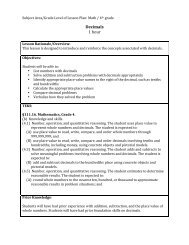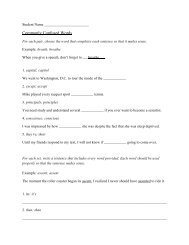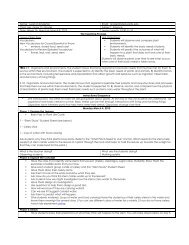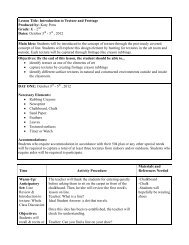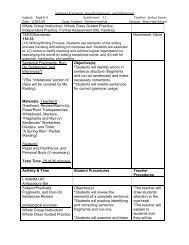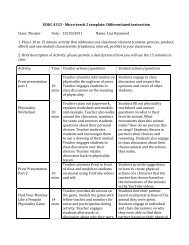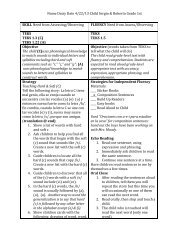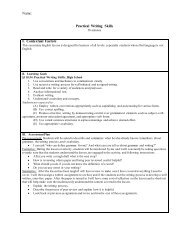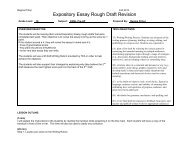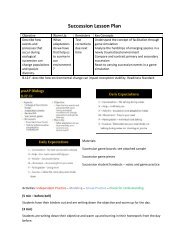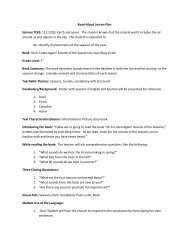Inference - St. Edwards University
Inference - St. Edwards University
Inference - St. Edwards University
You also want an ePaper? Increase the reach of your titles
YUMPU automatically turns print PDFs into web optimized ePapers that Google loves.
Allison Wooten<br />
Dates: 10/15/12-10/19/2012<br />
Subject: Language Arts<br />
Making <strong>Inference</strong>s<br />
<strong>St</strong>udent Expectations:<br />
The students are expected to identify and support the main idea in nonfiction and expository<br />
texts.<br />
TEKS:<br />
2.9 Reading/Comprehension of Literary Text/Fiction. <strong>St</strong>udents understand, make inferences and<br />
draw conclusions about the structure and elements of fiction and provide evidence from text to<br />
support their understanding.<br />
2.9(L1) sequence and summarize the plot’s main events and explain their influence on future<br />
events<br />
2.9B describe main characters in works of fiction, including their traits, motivations, and<br />
feelings<br />
2.9A describe similarities and differences in the plots and settings of several works by the same<br />
author.<br />
<strong>St</strong>udent Friendly Objectives (TEKS):<br />
I can make inferences about characters traits, feelings, and motivations.<br />
I can use main events to predict future events in fictional text.<br />
Value:<br />
<strong>St</strong>udents understand that the author uses clues in the text in order for the reader to draw<br />
conclusions and make inferences. In reading, students should be able to use events/words in<br />
the text and connect them to know what they know if real life to figure out what is happening<br />
in the text, what might happen in the future, how characters are feeling, and why characters do<br />
certain things.<br />
Vocabulary: Character, motivation, feelings, plot, problem, solution, predict, event, infer,<br />
inference, conclusion, evidence<br />
Guided Questions:<br />
How is ___________ feeling now How can you tell<br />
What motivated the character to do ____________ What is your evidence<br />
Based on events in the story, what will the ___________likely do next Why<br />
What do you predict will likely happen in the future What happened that makes you<br />
think this<br />
How did ___________’s actions impact the story/plot<br />
What lessons do you think ________ learned How can you tell<br />
What words can best be used to describe ________ Explain why you think this.
“Anchors of Support:”<br />
What is an inference Chart<br />
<strong>St</strong>rategies for Making <strong>Inference</strong>s Chart<br />
Graphic Organizer- T Chart<br />
Ask guiding questions using wording from the TEKS (SEs).<br />
Open ended questions/reader’s response (ask students to provide text<br />
evidence).Provide sentence stems:<br />
“I can tell that the character __________ because…”<br />
“_________ is feeling _________ because…”<br />
“I predict that _________ will happen in the future because…”<br />
“The reader can tell that…”<br />
“It is likely that _____________ will happen in the future because…”<br />
Important “background knowledge” students need to know:<br />
<strong>Inference</strong>s are conclusions that the reader makes. <strong>Inference</strong>s are not directly stated by the<br />
author. <strong>Inference</strong>s can be given as clues by the characters’ thoughts, actions, and words.<br />
Readers can also use text features, such as illustrations to make inferences.<br />
Important “misconceptions” needing clarification before new learning takes<br />
place:<br />
Technology to be used:<br />
Brain Pop Jr: Making <strong>Inference</strong>s<br />
What hands-on materials/activities will be used<br />
Graphic Organizers, sticky notes, and reference charts<br />
Monday:<br />
(20-25 minutes)<br />
Shared Reading or Read Aloud: The Sweetest Fig<br />
Materials Needed: The Sweetest Fig<br />
Graphic Organizer T-Chart<br />
Introduction: (carpet) Show students Brain Pop Jr: Making <strong>Inference</strong>s. Talk about what an<br />
inference is (we will be filling in a chart about inferences Tuesday). This is an open discussion<br />
about what an inference is. The video will give the students some idea of what an inference can<br />
be or what it can look like. Introduce book The Sweetest Fig and new T-chart graphic organizer.<br />
Explain that this is what they will be using for when they are making their own inferences.<br />
Emphasize importance of engaged behaviors because they will be doing this on Thursday and<br />
Friday with their partners and/or by themselves.
Procedure: READ, STOP and RETELL. See sticky notes in book for guiding questions. At each<br />
stopping point write on the chart appropriate information. Continue to do this for the whole<br />
book.<br />
Closing: Review what an inference is as well as how we came to an inference while reading.<br />
(25-30 minutes)<br />
Read to self: have students get library books and get into their respective book nooks.<br />
Guided Reading: DRA 10-Remember Me, DRA 16-Daniel’s New Home, DRA 18-The New<br />
Americans, DRA 30-Eva’s Journey. Discuss title & Text features. Discuss genre: historical fiction<br />
(I will not be doing the Guided Reading this week but I wanted to include it so I am able to see<br />
how it will look on a lesson plan.)<br />
Tuesday:<br />
(20-25 minutes)<br />
Shared Reading or Read Aloud: The Widow’s Broom<br />
Materials Needed: The Widow’s Broom<br />
Graphic Organizer T-chart<br />
What is an <strong>Inference</strong> Chart<br />
Introduction: (carpet) Fill out what is an <strong>Inference</strong> Chart with student ideas. Have them recall<br />
the Brain Pop video about inferences. This should be a quick overview. Explain that we will be<br />
making inferences with today’s book just like the previous book. Emphasize importance of<br />
knowledge of how to complete this chart because they will have to do it Thursday and Friday<br />
for assessment.<br />
Procedure: READ, STOP and RETELL. See sticky notes in book for guiding questions. At each<br />
stopping point write on the chart appropriate information. Continue to do this for the whole<br />
book.<br />
Closing: Review what an inference is as well as how we came to an inference while reading.<br />
(25-30 minutes)<br />
Read to self: have students get library books and get into their respective book nooks.<br />
Guided Reading: Read chapter one of each book with different DRA leveled groups. Discuss<br />
selected vocabulary in each text. Present a guiding question and discuss with students. Fill out<br />
the graphic organizer as a group.<br />
Wednesday:<br />
(20-25 minutes)
Shared Reading or Read Aloud: Babushka’s Doll<br />
Materials Needed: Babushka’s Doll<br />
Graphic Organizer T-chart<br />
Introduction: (carpet) Reference to the what is an <strong>Inference</strong>s chart you made on Tuesday.<br />
Explain that we will be making inferences with today’s book just like the previous book.<br />
Emphasize importance of knowledge of how to complete this chart because they will have to do<br />
it Thursday and Friday for assessment. This is their last day to have a model read aloud.<br />
Procedure: READ, STOP and RETELL. See sticky notes in book for guiding questions. At each<br />
stopping point write on the chart appropriate information. Continue to do this for the whole<br />
book.<br />
Closing: Review what an inference is as well as how we came to an inference while reading<br />
(25-30 minutes)<br />
Read to self: have students get library books and get into their respective book nooks.<br />
Guided Reading: Read chapter two of each book with different DRA leveled groups. Discuss<br />
selected vocabulary in each text. Present a guiding question and discuss with students. Fill out<br />
the graphic organizer as a group.<br />
Thursday:<br />
(20-25 minutes)<br />
Model of end of week assessment: “Night Shape”<br />
Materials needed: “Night Shape” (40 copies total for all students and myself)<br />
Graphic organizer for overhead<br />
Introduction: Explanation of what students are expected to do and that this is a model for<br />
tomorrow’s assessment. Make sure to include I can statement as well as the expectations.<br />
Procedure: Have students read the passage with you. Explain we will READ, STOP and RETELL.<br />
Complete chart exactly like it was being done during read alouds.**Make sure you fill out<br />
graphic organizer as you go.**<br />
Closing: Review what an inference is as well as how we came to an inference while reading.<br />
Explain that we will be having an assessment tomorrow on their own.<br />
(25-30 minutes)
Read to self: have students get library books and get into their respective book nooks.<br />
Guided Reading: Read chapter three of each book with different DRA leveled groups. Discuss<br />
selected vocabulary in each text. Present a guiding question and discuss with students. Fill out<br />
the graphic organizer as a group.<br />
Friday:<br />
(20-25 minutes)<br />
End of Week Assessment: “Noah’s Trip”<br />
Materials needed: “Noah’s Trip” for each student (40 total)<br />
Graphic Organizer for each student (40 total)<br />
Introduction: Review previous inference strategies that we have been practicing. Read<br />
directions to students and give them clear expectations. Also if there is a checklist generated,<br />
present this to the students. Read the title and passage together with students.<br />
Procedure: After brief introduction and read aloud give students the passage. Have them all<br />
read it together once more. (Cheetah paws up) Walk around the classroom while the students<br />
take their test. Answer questions as needed.<br />
(25-30 minutes)<br />
Read to self: have students get library books and get into their respective book nooks.<br />
Guided Reading: Read chapter four of each book with different DRA leveled groups. Discuss<br />
selected vocabulary in each text. Present a guiding question and discuss with students. Fill out<br />
the graphic organizer as a group.<br />
Formative assessment(s) to be used to monitor student understanding<br />
throughout the week:<br />
Teacher Observation<br />
Guided Questions<br />
Small Group Discussion<br />
Differentiate for ELPs, Resource and G/T <strong>St</strong>udents by:<br />
Demonstration<br />
Gestures<br />
Graphs and charts to communicate information<br />
Hands-on manipulatives<br />
Model activities<br />
Model appropriate, grade level academic language<br />
Pre-teach vocabulary
Randomize student response<br />
Table talk<br />
Think-pair-share<br />
Use of multimedia<br />
Visuals




